General Information
Spiders are arachnids and closely related to other arachnids like ticks, mites and scorpions. They have two body regions, no antennae and eight legs. Spiders help to kill pests both inside and outside of buildings and are beneficial. There are only a few spiders whose bite requires medical attention, such as the western or black widow spider, brown recluse spider, yellow sac spider and hobo spider.
Widow spiders, Lactrodectus spp., are common throughout the United States. Bites from widow spiders are painful, generally not fatal, but dangerous because they contain a nerve toxin. There are various types of Black widow spiders- northern black widow, southern black widow and western black widow. There are also brown widows found from Texas to Georgia to South Carolina as well as parts of California. Red widows can be found in Florida.
Identification
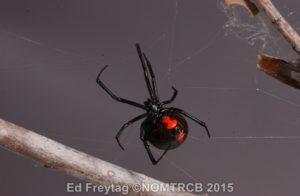 |
Black widow spiders (Lactrodectus mactans) adult females are a solid black spider with a bulbous abdomen (hind section) and a red hourglass on its underside (not on top). Males are much smaller than the females but have similar coloring. Red widows have reddish-orange head, thorax and legs with a black abdomen. The top of their abdomen has a row of red spots and the underside lacks a complete hourglass. Brown widows are a mottled tan and brown with black accents. |
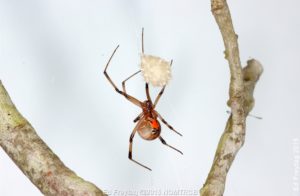 |
The brown widow spider (Latrodectus geometricus) can vary in color from white, dark brown, to almost black, however most are light or medium brown. The ventral side of the abdomen contains an orange or yellow colored hourglass shaped marking, brown shaded bands on leg segments, white spots on the abdomen, and white stripes marginally. The white abdominal stripes can distinguish this species from the black widow, but the white stripes are often difficult to see on darker colored brown widow spiders. The body size differs by gender; the female body length is typically 12-16mm (not including legs), while the male’s length is 6-8mm, but with longer legs compared to that of the female. |
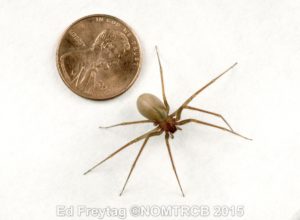 |
Brown Recluse spiders (Loxosceles reclusa), are often identified by the violin-shaped marking on their cephalothorax, but other spiders may have similar markings. It is best to look at the eye pattern; recluse spiders have six equal sized eyes arranged in three pairs along the front of the head. Recluse spiders like to hide in out of the way places that are not often disturbed, but they emerge at night to hunt for prey. It is possible for them to seek shelter in clothing, shoes or other items that may bring them into association with humans. Their venom contains a cytotoxin that can cause necrotic skin lesions. |
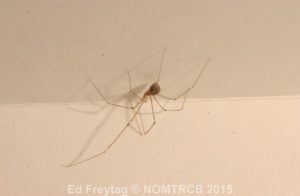 |
Cellar spiders (Pholcidae spp.) live in dark corners of cellars, crawl spaces, and garages. Spiders in this family have long and skinny legs with small bodies. They are true spiders that spin untidy webs which are often quite extensive. Cellar spiders typically stay in one place, don’t bother people, and are not known to bite. |
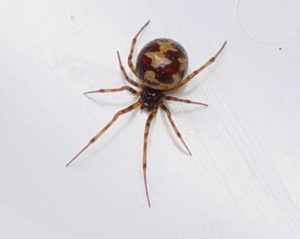 |
Cobweb spiders/House spiders (Theridiidae spp.) are common inhabitants of dark corners around the home. They have a generally bulbous body and create messy webs with sticky threads. The majority of these spiders are harmless and helpful at reducing insects that may be found indoors. |
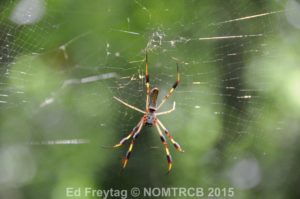 |
Funnel weaver spiders, or grass spiders, are small to medium sized spiders. The three most common genera (Agelenopsis, Hololena, Tegenaria) are found in homes and schools. They are often brown with gray, black and tan markings and usually have bristly legs. These spiders build funnel shaped webs close to the ground which provides shelter for them as they wait for prey to come near the web. Funnel weavers may enter buildings during late summer and early fall. They produce dense mats of silk in areas such as shrubs, thick grass, or corners of buildings. Funnel weaver spiders are sometimes mistaken for the brown recluse, a potentially poisonous species. These spiders are considered to beneficial predators. |
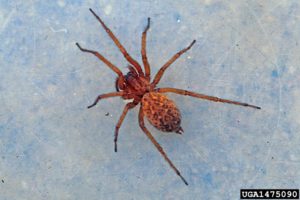 |
Hobo spiders (Eratigena agrestis), are found in the Northwestern United States and into parts of Canada. They make a funnel type web which it uses as a snare to capture prey. The hobo spider is brown with an eye pattern of two rows of four eyes each that are strongly curved downward. To truly determine if you have a hobo spider instead of a different species of funnel web spider, an arachnologist (spider specialist) must examine the reproductive structures. Hobo spiders have a bite that can cause necrosis, similar to that of recluse and sac spiders. |
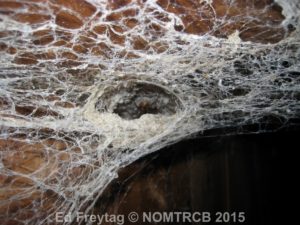 |
Sac spiders (Eutichuridae spp.) get their name because they spend daylight hours in a flattened silken sac, often in the upper corners of rooms or in wall cracks. Most sac spiders are pale colored. Sac spiders are suspected as being the most common source of spider bites in homes. They are active hunters, frequently found wandering in homes during fall, particularly at night. Their venom is cytotoxic, causing tissues at the bite site to die (necrosis). |
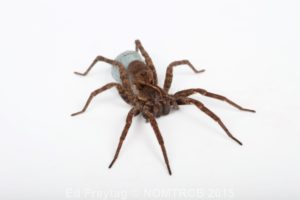 |
Wolf spiders (Lycosidae spp.) are active hunters that do not produce a snaring web. Most are grey or brown and some are quite large. Wolf spiders occasionally enter buildings, particularly in areas of new development where their habitat was disturbed. They are normally shy and not dangerous to humans, although large species can bite. |
Suggested Thresholds
Unless spiders are venomous, they can be left in place to help with biological control.
Monitoring and Inspection
- Using a flashlight, inspect corners, along edges, by light fixtures and windows as well as under cabinets and furniture.
- Move objects for inspections, wear gloves to avoid any bites.
- Outside inspect along the foundation of the structure, especially near areas with landscaping.
- Check electrical boxes, irrigation boxes and other protected areas.
- Use glueboards/ sticky traps in suspected areas of infestation to monitor spider populations.
Nonchemical Control Measures
Sanitation/Cultural Control Measures
- Change exterior lighting from the standard lights to sodium vapor bulbs to limit prey insects coming to the building.
- If possible, direct lighting away from the structure. Prune back any vegetation that overhangs or touches the structure.
- Vacuum regularly to suck up spiders, webbing, and other insects that can serve as food for spiders.
- Cobweb dusters, brooms or vacuums can be utilized to remove webbing.
- Minimize clutter in rooms to reduce areas suitable for spiders to hide, reproduce, and lay eggs.
Physical/Mechanical Control Measures
- Use sealant around all pipe and wire penetrations and to seal any cracks that may lead into the structure.
- If the building has weepholes, use copper mesh to block spiders from entering wall void areas.
- Ensure items are being stored correctly, use plastic storage bins with sealing lids or tape all seams of boxes to reduce spiders that may take up residence inside.
- Use sticky traps along baseboards to monitor and help control ground dwelling spiders.
Biological Control Measures
Inside, spiders may be eaten by geckoes or other small lizards that enter the building, but these creatures are often unwanted indoors as well. Outside, spiders may be eaten by other spiders, frogs, toads, lizards, birds or small mammals.
Chemical Control Measures
Interior or exterior insecticidal sprays are generally ineffective at reducing spider populations, but may provide some repellency. Pyrethroid insecticides such as bifenthrin, cyfluthrin, deltamethrin, lambda-cyhalothrin, esfenvalerate can help reduce but they will not kill all the spiders. Pyrethroids can be hazardous to aquatic insect and fish life. An alternative to spraying ceilings and rafters in such locations is to treat a screen or fabric that can then be hung over sensitive sites to catch spider droppings and prevent nest building underneath the netting.
Non-repellent dust formulations applied to webs are often more effective. Residual dusts can be applied to voids and inaccessible areas where spiders hide. Wettable powders or microencapsulated formulations of residual pesticides are sometimes applied to corners, in storage areas, etc. to control active hunting spiders and reduce reestablishment of new spiders. Aerosol flushing agents such as pyrethrins, though ineffective by themselves in providing long-term control, can cause spiders to move about so that they can be removed with a vacuum.
Evaluation Methods
Inspect for spiders and their webbing using a flashlight.
